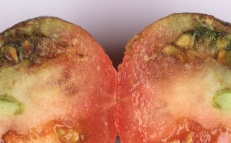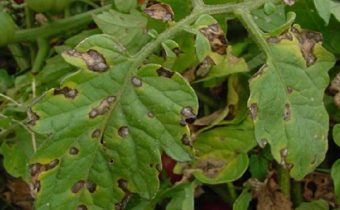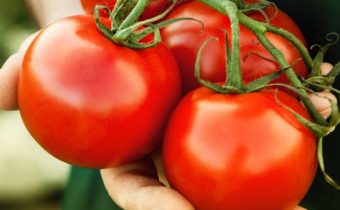Why tomatoes crack, how to avoid it?
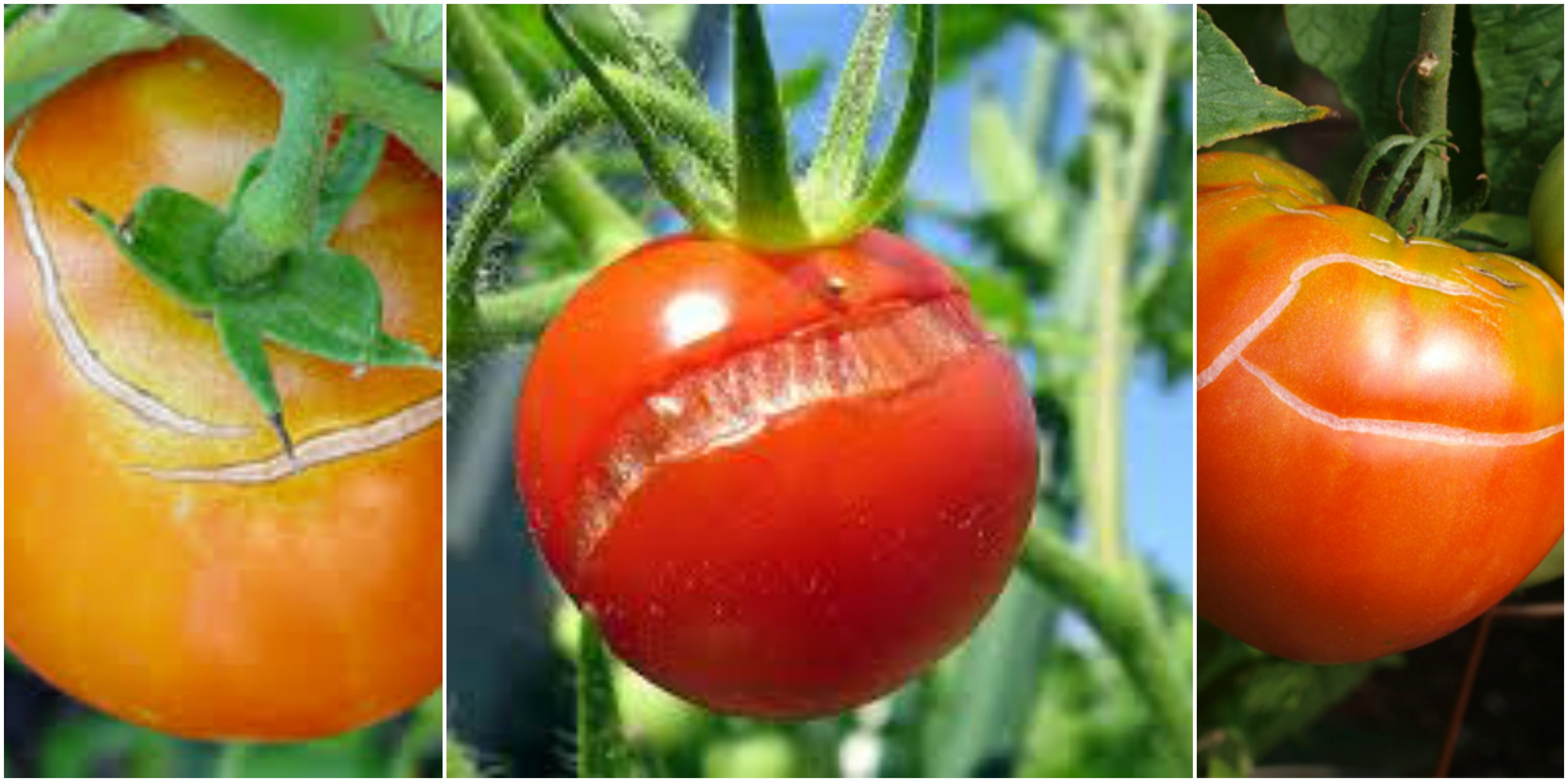
The cracking of tomato fruits during ripening is an unpleasant defect, leading to a decrease in the quality of the crop. Most often this phenomenon is observed on varieties of yellow and pink thin-skinned tomatoes. However, it can also be found on other tomato varieties. Rupture of the skin is a non-infectious disease, and the result of improper care and abrupt changes in environmental conditions.
What is dangerous cracking tomatoes
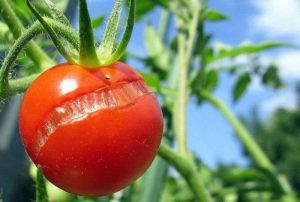 On the one hand - well, the skin of the fruits cracked, because there is nothing wrong with that! This is not a disease. But the pleasant in the appearance of such a lack is also small. Even if we do not assume that the burst tomatoes lose their attractiveness and presentation (which is very bad for a farmer who grows tomatoes for sale), one cannot escape the unfortunate consequences that the "torn" fruits expect. The fact is that the cracks are the gateway for the penetration of various fungi, viruses and bacteria. In addition, fragrant tomato juice will lure insects - lovers of sweet vegetables. If tomatoes grow in a greenhouse, where infections spread very quickly, then most likely these fruits will become sick, and part of the crop will be lost at the time of harvest. True, it is hoped that the wounds will have time to tighten with cork cloth before it gets an infection.
On the one hand - well, the skin of the fruits cracked, because there is nothing wrong with that! This is not a disease. But the pleasant in the appearance of such a lack is also small. Even if we do not assume that the burst tomatoes lose their attractiveness and presentation (which is very bad for a farmer who grows tomatoes for sale), one cannot escape the unfortunate consequences that the "torn" fruits expect. The fact is that the cracks are the gateway for the penetration of various fungi, viruses and bacteria. In addition, fragrant tomato juice will lure insects - lovers of sweet vegetables. If tomatoes grow in a greenhouse, where infections spread very quickly, then most likely these fruits will become sick, and part of the crop will be lost at the time of harvest. True, it is hoped that the wounds will have time to tighten with cork cloth before it gets an infection.
Tip!
Cracked fruits must be removed from the bush immediately after detection and allowed to be recycled, as they cannot be stored.
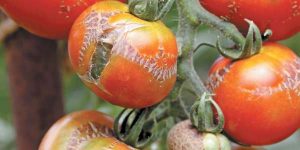
Why do tomatoes burst
The appearance of ugly cracks on smooth beautiful fruits - the picture is far from aesthetic. Their appearance should immediately alert the gardener, because this is a sign that the care is wrong. There are many reasons for this occurrence. The main ones are:
- Wrong watering. The most common cause of deformation of a tomato is irregular watering. If you keep the land dry for a long time, the growth of plants stops growing. But if you suddenly start to water them abundantly, then it activates the biological processes occurring inside the plant. All parts of the bush will begin to intensively absorb water, while increasing the energy of growth. Fruits quickly grow in size and burst. This can happen not only on ripe fruits, but also on green tomatoes.
- Watering during the heat. Everyone knows that greenhouse earth dries faster than open land. If the dry land is poured with water, then the roots, which are thirsty for a long time, will begin to suck water and nourish the plant. As a result, it will happen that with irregular watering - unripe tomatoes are cracked.
- Unsuitable microclimate in the greenhouse. In a greenhouse it is often unbearably hot. Sometimes the temperature rises above 40 degrees, which causes a halt in the development of plants and the fall of the ovaries. Already formed fruits at high temperatures stop growingand their skin hardens. As soon as the conditions for growth become comfortable, the fruit will develop further, but, the hard skin will not withstand the onslaught of the force of growth and break - multiple cracks will appear.
By the way!
Abrupt changes in night and day temperatures also lead to cracks in the skin.
- Pinching bushes. Many gardeners pinch the top of the bushes during fruit ripening. They explain this by redirecting the strength of the plant to fruit.However, experts see this as a problem leading to cracking of the skin. The fact is that the moisture that was supposed to go to the apical stems, accumulates in the fruit, because it has nowhere else to go, and this causes its pressure to break the skins. This mainly occurs during low night temperatures.
- Exposure of the bushes. Often gardeners are so keen on pasynkovanie that leave the bushes bare. The smaller the shoots will have a plant, the more water will accumulate in the fruit (although it was intended for remote stepsons and leaves). The rapid growth of tomatoes will lead to rupture of the tissues of the unformed skin.
- Fertilizer games. The quality of the fruits suffers greatly when improper use of fertilizers - making the wrong formulations, doses, neglecting the timing of dressing. For proper ripening of the fruit, the plant needs minerals, and if they are not delivered on time in the right quantity, the tomatoes are deformed and sometimes crack.
- Infectious diseases. Cracking fruits sometimes leads not to agricultural technology, but to the disease that has appeared. Infection often spoils ripening fruits - stains, stains, cracks, wounds appear on them. Alternaria, rot, are considered to be dangerous diseases with such symptoms. phytophtora. A strong fungicidal agent of chemical origin will help to correct the situation.
Preventing Cracking Tomatoes
As we found out, tomatoes are cracking due to improper agricultural practices. Avoid the appearance of a defect will help compliance with the rules of care and preventive measures:
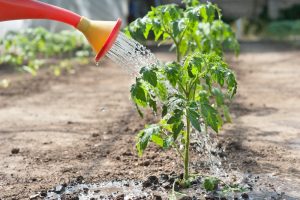
- Conducting competent watering. It is recommended to water the beds with tomatoes often, but only moderately. Bushes must always have access to water and "live" exclusively in semi-moist soil. Particular attention should be paid to watering during flowering and fruiting. In the heat, watering is carried out once every three days, spending 3-4 liters of water per bush. On cloudy days, one watering in five days is enough. Water is delivered to the roots in batches, so that the moisture is evenly distributed in the soil.
- The problem of waterlogging is often found in the open field. When, for example, there was a drought for a long time, and then there was a sharp rain. Plants absorb excess water, with the result that the walls of the fruit can not withstand the load and tear. To avoid such a situation it is necessary to keep the beds under a shed during periods of frequent precipitation.
- To keep moisture in the ground for as long as possible, it must be mulched. It is important to do both in open ground and in the greenhouse. As the soil, you can use straw, sawdust or grass. But to use compost in the form of mulch is undesirable, since it can cause overheating of the roots.
- Temperature control. Often in greenhouses there is an increased temperature of air, which leads to a delay in the growth of fruits. After lowering the temperature, the tomatoes begin to grow rapidly in size, which leads to broken skin, which during the drought has managed to harden. Comfortable temperature for tomatoes in the greenhouse - 20-22 degrees during the day and 16-18 degrees at night. To cool the air in the greenhouse during the daytime, you can use barrels of cold water (water will take excess heat during the day to warm up).
- The implementation of airing. If tomatoes grow in a greenhouse, then it is necessary to control the level of humidity and heat in the room, avoiding either overmoistening or drought. In the summer, the doors and windows of the greenhouse must be constantly open, so that pure oxygen comes to the plants, and there is no condensation between the bushes.
- Sun protection. Tomatoes should not be in direct sunlight, which causes burns of leaves and cracking of fruits. To do this, over the bed (or above the greenhouse) stretch the awning or scattering grid. The walls of the greenhouse can be painted with lime milk.
- Fertilization. Tomatoes should be fed every two weeks.With a lack of nitrogen most often observed cracking of the fruit. However, its excess generally leads to their absence. Nitrogen is introduced into the soil during growth of the shrub and roots, and potassium and phosphorus - during flowering and fruit formation. If during the ripening of the fruits they do not have enough potash fertilizers or nitrogenous, their quality will be seriously affected. During the period of fruit ripening, phosphate fertilizers should be discarded.
- For dressing it is necessary to use only mineral compounds diluted in water. The introduction of a concentrate of potassium, nitrogen or phosphorus will only contribute to the inhibition of the plant, an imbalance in the development of fruits. As a result, the tomatoes are formed clumsy, cracked, small. Fertilizer consumption for tomatoes - 20 grams of minerals per bucket of water.
- You can not remove all stepchildren at the same time - this can lead to plant disease. For the procedure removed only 2-3 extra shoots. Masking is done once a week.
Cracking varieties
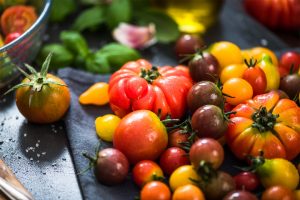 Many yellow and pink varieties of tomatoes, with a thin skin, as well as early maturing hybrids most often subjected to cracking of the skin. Varieties with medium ripening periods suffer from this disease much less often. But later varieties have practically no problems with bursting sandpaper. It is also necessary to choose varieties with a thick crust that are resistant to drought and excessive moisture that can endure all the wrong care. These include:
Many yellow and pink varieties of tomatoes, with a thin skin, as well as early maturing hybrids most often subjected to cracking of the skin. Varieties with medium ripening periods suffer from this disease much less often. But later varieties have practically no problems with bursting sandpaper. It is also necessary to choose varieties with a thick crust that are resistant to drought and excessive moisture that can endure all the wrong care. These include:
- Bohemia A1.
- Pear.
- Crimson Viscount.
- Pink honey.
- Asteroid.
- Lady fingers.
Varieties that tolerate excess moisture, have a late ripening period:
- Vladimir F1.
- Rio Grand.
- Farm pickle.
- Miracle of the earth.
- Bear Paw.
The most popular varieties are not prone to cracking the peel:
- Near Moscow
- Hercules
- Harlequin.
- Betta
- Diva.
- Favorite.
- Our Masha.
- Beautiful Lady and others.
Using the “right” varieties, observing the rules of agrotechnology, introducing poorly concentrated feedings and arranging portion irrigation, most likely, the problem with the burst tomatoes will not disturb you, and you will get a tasty sweet crop of tomatoes that you can decorate the dish with and sell it on the market.


